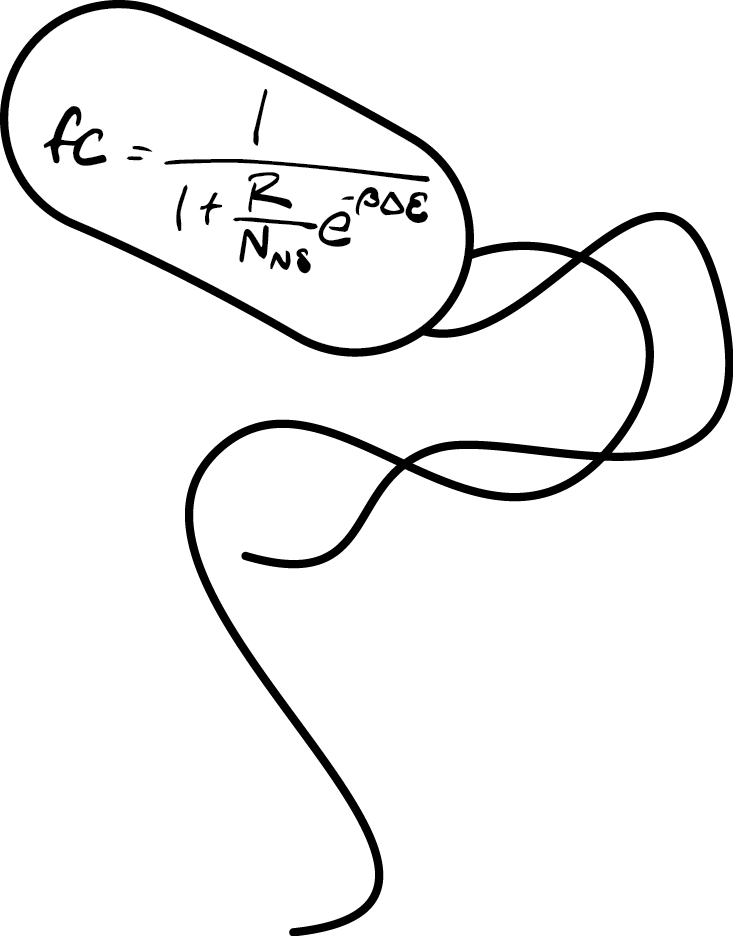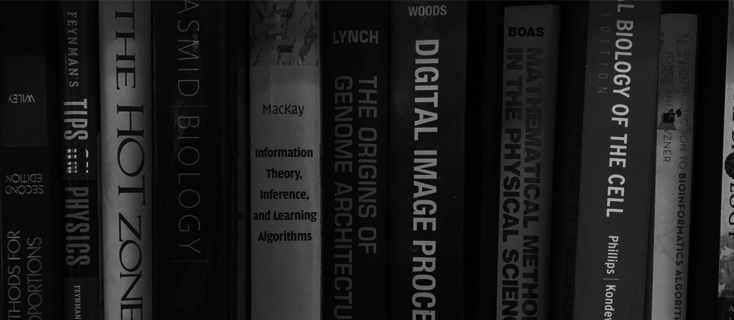In-Class Readings
Readings mentioned specifically in class will be listed here as the course progresses.
Monday, January 16
A feeling for the numbers in biology by Rob Phillips and Ron Milo (2009) PNAS 106, pp. 21465-71.
This paper describes the role of biological numeracy in thinking about a variety of problems.
Street fighting mathematics by Sanjoy Mahajan. This a free textbook on the art of performing back-of-the-envelope calculations.
Guesstimation: Solving the worlds’ problems on the back of a cocktail napkin by Lawrence Weinstein and John A. Adam. Another textbook which covers principles of estimation.
Tuesday, January 17
Real-time kinetics of gene activity in individual bacteria by Golding, Paulsson, Zawilski, and Cox. The nice work that Rob spoke about to experimentally count mRNA.
Models in biology: ‘accurate descriptions of our pathetic thinking by Jeremy Gunawardena.
Wednesday, January 18
How to make a Biological Switch by Cherry and Adler. This is the paper that Rob mentioned about genetic switches. It contains some of the work we went through in class, if you’d like to look into this further.
Thursday, January 19
Polymer physics of intracellular phase transitions by Brangwynne, Tompa, and Pappu. This is the review paper in Nature Physics related to phase transitions and droplets that was discussed in class.
Germline P Granules Are Liquid Droplets That Localize by Controlled Dissolution/Condensation by Brangwynne et al. in Science and A nuclear F-actin scaffold stabilizes ribonucleoprotein droplets against gravity in large cells by Feric and Brangwynne in Nature Cell Biology. These are two other fascinating papers from Clifford Brangwynne related to our discussions in class today.
Friday, January 20
Yeast kinesin-8 depolymerizes microtubules in a length-dependent manner by Vargas et al. and Design Principles of Length Control of Cytoskeletal Structures by Mohapatra et al. are two great papers if you’d like to read more about cytoskeletal filaments and quantitative approaches to describe their lengths and dynamics.
Engineering Maxwell’s demon by Lu et al. If you were curious about Maxwell’s demon (or still confused), take a look at this paper. Also search the internet for Ralf Landauer and Charles Bennett.
Kinetic proofreading: a new mechanism for reducing errors in biosynthetic processes requiring high specificity by John Hopfield and Kinetic Amplification of Enzyme Discrimination. Biochimie by Jacques Ninio. How can cells manage to perform replication, transcription, and translation with such low error rates!? These papers are very relavent to the lecture today.
These two articles were mentioned in Rob’s wrap-up; about the risks of big data and the need for a solid theoretical footing: The End of Theory: The Data Deluge Makes the Scientific Method Obsolete by Chris Anderson, which tries to argue that we do not need theory, while Turing centenary: Life’s code script from Sydney Brenner who takes Rob’s view on the need of theory.
Brenner, S. (2012). Turing centenary: Life’s code script. Nature.
Supplementary reading
The papers provided here are meant to provide an entry point into the literature for going more deeply into various topics covered -in class. These papers have been picked either because they provide interesting and provocative experimental measurements of particular biological phenomena or because they show how to go about constructing theoretical models in the physical biology spirit described in the course. The papers that of most direct relevance to what we will cover in class are linked on the “Syllabus” part of the website.
Biology by the numbers
Uri
Moran et al., (2010), SnapShot: Key Numbers in Biology,
Cell 141, pp.1262
List of key numbers in biology, such as
the quantity and size of cellular components and the rates of cellular
processes.
Sean Eddy (2004), What is Bayesian statistics? Nature Biotechnology 22, pp. 1177-178.
This paper gives a compact but beautiful example of the
power of Bayesian methods for figuring out the
probability ofsome hypothesis given the data.
Hernan Garcia et al. (2007), A First Exposure to Statistical Mechanics for Life Scientists.
This paper is a brief introduction to ideas from statistical mechanics that can
be used to analyze a variety of problems in biology.
The physics of genome management
Roger Kornberg and Lubert Stryer (1988), Statistical distribrutions of nucleosomes: nonrandom locations by a stochastic mechanism, Nucleic Acids Research 16, pp. 6677-90.
This paper shows how a simple model of excluded volume predicts how nucleosomes will be organized around promoters.
Eran Segal et al. (2006), A genomic code for nucleosome positioning, Nature 442, pp. 772-8.
This paper describe work aimed at determining genome wide nucleosome positioning preferences.
Noam Kaplan et al. (2009), The DNA-encoded nucleosome organization of a eukaryotic genome, Nature 458, 362-6.
This paper describe work aimed at determining genome wide nucleosome positioning preferences.
Paul Wiggins et al. (2010), Strong intranucleoid interactions organize the E. coli chromosome into a nucleoid filament, PNAS 107, pp. 4991-5.
This paper looks at the spatial organization of the genome in a cell.
Douglas Smith et al. (2001), The bacteriophage Φ29 portal motor can package DNA gains a large internal force, Nature 413, 748-52.
In this paper, optical tweezers are used to study the forces needed to package double-stranded DNA into a viral capsid.
Alexander Tsankov et al. (2010), THe role of nucleosome positioning in the evolution of gene regulation, PLoS Biology 8, e1000414.
This interesting paper examines the genome-wide nucleosome positions in
12 different yeast species. This data provides an excellent jumping off
point for models of nucleosome positioning.
K.J. Plach and J. Widom (1995), Mechanism of protein access to specific DNA sequences in chromatin: A dynic equilibrium model for gene regulation, JMB 254, 130-49.
This paper examines how different sites within nucleosomes
grant access to DNA binding proteins and quantifies how this
accessibility depends upon the depth of the sites of interest
within the nucleosome.
Regulatory biology
Hernan Garcia and Rob Phillips (2011), Quantitative dissection of the simple repression input-output function, PNAS 108(29) pp. 12173-8.
This paper demonstrates that thermodynamic models can make
quantitative predictions about the level of gene expression as
a function of repressor copy number and operator strength.
Lacramioara Bintu et al. (2005), Transcriptional regulation by the numbers: models, Current Opinions in Genetics and Development 15, pp. 116-24.
This paper outlines an approach to creating quantitative models
of gene expression using thermodynamics of the binding of
transcription factors and RNA polymerase to DNA.
This paper clearly demonstrates that the process by which mRNA is produced in the E.coli cell is stochastic in nature. A surprising observation is that the mRNA distribution is not Poisson, characterized by bursts in mRNA production. To this day the source of the stochasticity remains a mystery.
Victor Sourjik and Howard C. Berg (2002), Receptor sensitivity in bacterial chemotaxis, PNAS 99, 132-7 and
Victor Sourjik and Howard C. Berg (2002), Binding of the
Escherichia coli </i> response regulator CheY to its
target measured in vivo by fluorescende resonance energy
transfer,</i> PNAS 99, pp. 12669-74.
These two papers use the method of FRET to examine the relation
between chemoattractant concentration and the chemical
reactions within cells that control the frequency of tumbles.
Juan Keymer et al. (2006), Chemosensing in Escherichia coli: Two regimes of two-state receptors, PNAS 103, pp. 1786-91.
and
Bernardo A. Mello and Yuhai Tu (2005), An allosteric model
for heterogeneous receptor complexes: Understanding
bacterial chemotaxis responses to multiple stimuli,
PNAS 102(48), pp. 1753-9.
Theory of chemotaxis: These two papers show how simple ideas
from equilibrium statistical mechanics can be used to
understand the chemotactic response of E. coli to different
concentrations of chemoattractant.


